HONDA ELEMENT 2007 1.G Owners Manual
Manufacturer: HONDA, Model Year: 2007, Model line: ELEMENT, Model: HONDA ELEMENT 2007 1.GPages: 275, PDF Size: 4.16 MB
Page 221 of 275
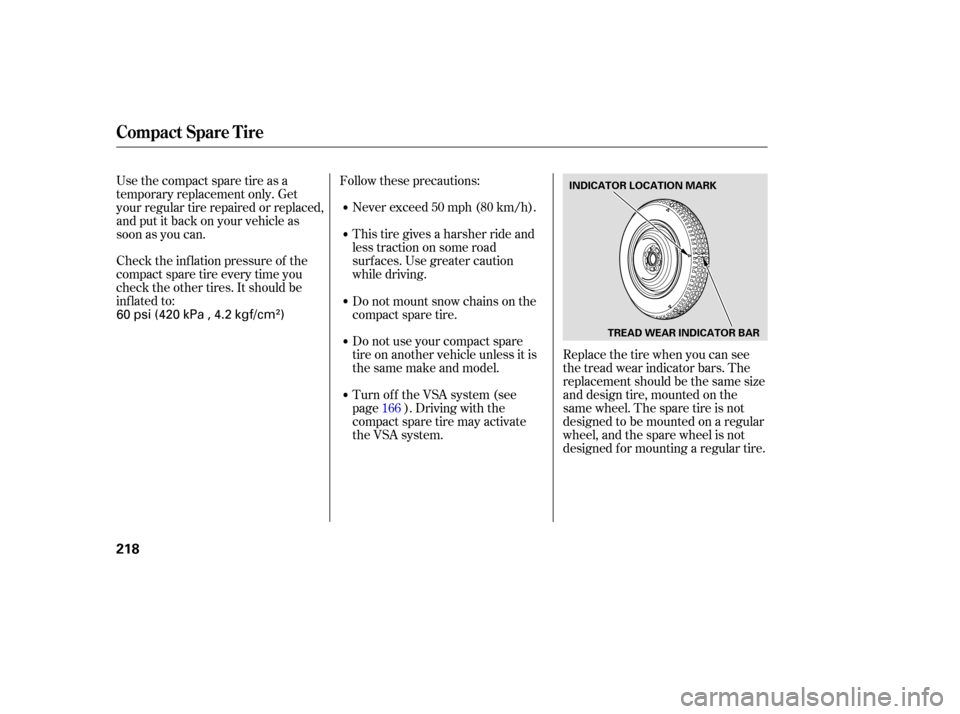
Check the inflation pressure of the
compact spare tire every time you
check the other tires. It should be
inflated to: Follow
these precautions:
Never exceed 50 mph (80 km/h).
This tire gives a harsher ride and
less traction on some road
surfaces. Use greater caution
while driving.
Use
the compact spare tire as a
temporary replacement only. Get
your regular tire repaired or replaced,
and put it back on your vehicle as
soon as you can.
Replace the tire when you can see
the tread wear indica tor bars. The
replacement should be the same size
and design tire, mounted on the
same wheel. The spare tire is not
designed to be mounted on a regular
wheel, and the spare wheel is not
designed for mounting a regular tire.
Do
not mount snow chains on the
compact spare tire.
Do not use your compact spare
tire on another vehicle unless it is
thesamemakeandmodel.
Turn of f the VSA system (see
page ). Driving with the
compact spare tire may activate
the VSA system. 166
Compact Spare Tire
218
INDICATOR LOCATION MARK
TREAD WEAR INDICATOR BAR
60 psi (420 kPa , 4.2 kgf/cm)
Page 222 of 275
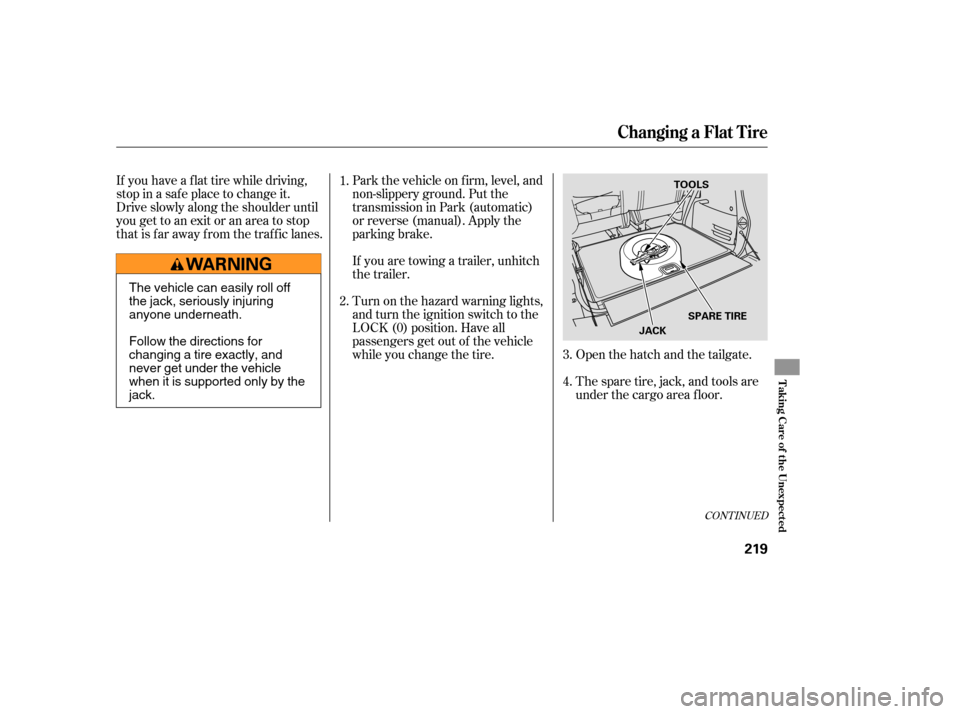
If you have a f lat tire while driving,
stop in a saf e place to change it.
Drive slowly along the shoulder until
you get to an exit or an area to stop
that is far away from the traffic lanes.Open the hatch and the tailgate.
The spare tire, jack, and tools are
under the cargo area f loor.
Park the vehicle on f irm, level, and
non-slippery ground. Put the
transmission in Park (automatic)
or reverse (manual). Apply the
parking brake.
If you are towing a trailer, unhitch
the trailer.
Turn on the hazard warning lights,
and turn the ignition switch to the
LOCK (0) position. Have all
passengers get out of the vehicle
while you change the tire.
1.
2.
3.
4.
CONT INUED
Changing a Flat Tire
T aking Care of t he Unexpect ed
219
TOOLS
SPARE TIRE
JACK
The vehicle can easily roll off
the jack, seriously injuring
anyone underneath.
Follow the directions for
changing a tire exactly, and
never get under the vehicle
when it is supported only by the
jack.
Page 223 of 275
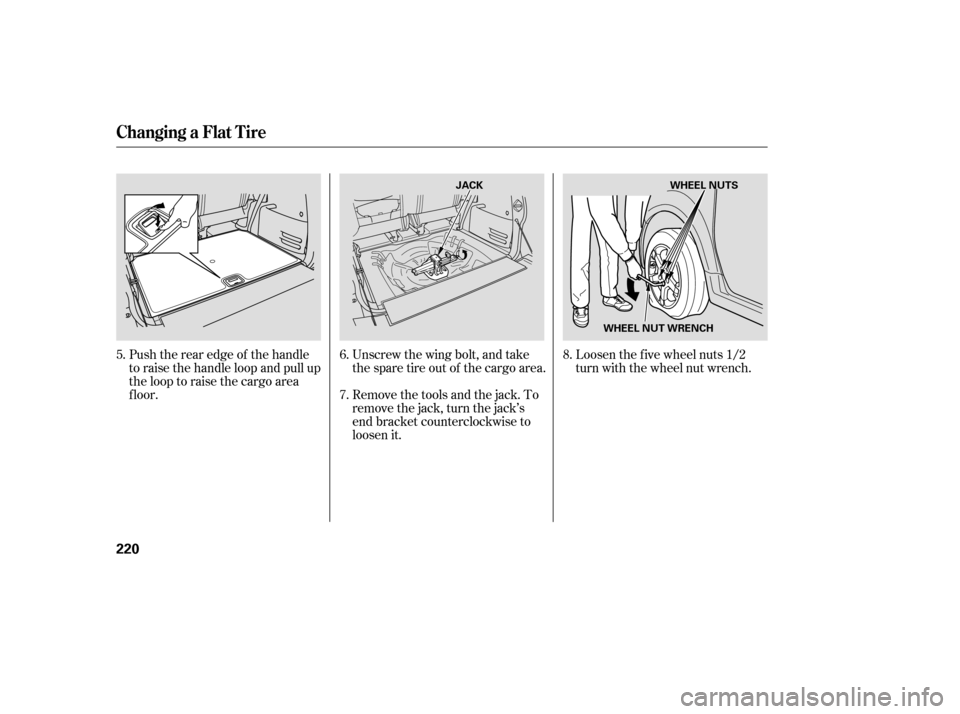
Push the rear edge of the handle
to raise the handle loop and pull up
the loop to raise the cargo area
f loor.Unscrew the wing bolt, and take
the spare tire out of the cargo area.
Remove the tools and the jack. To
remove the jack, turn the jack’s
end bracket counterclockwise to
loosen it.Loosen the f ive wheel nuts 1/2
turn with the wheel nut wrench.
8.
7. 6.
5.
Changing a Flat Tire
220
WHEEL NUTS
JACK
WHEEL NUT WRENCH
Page 224 of 275
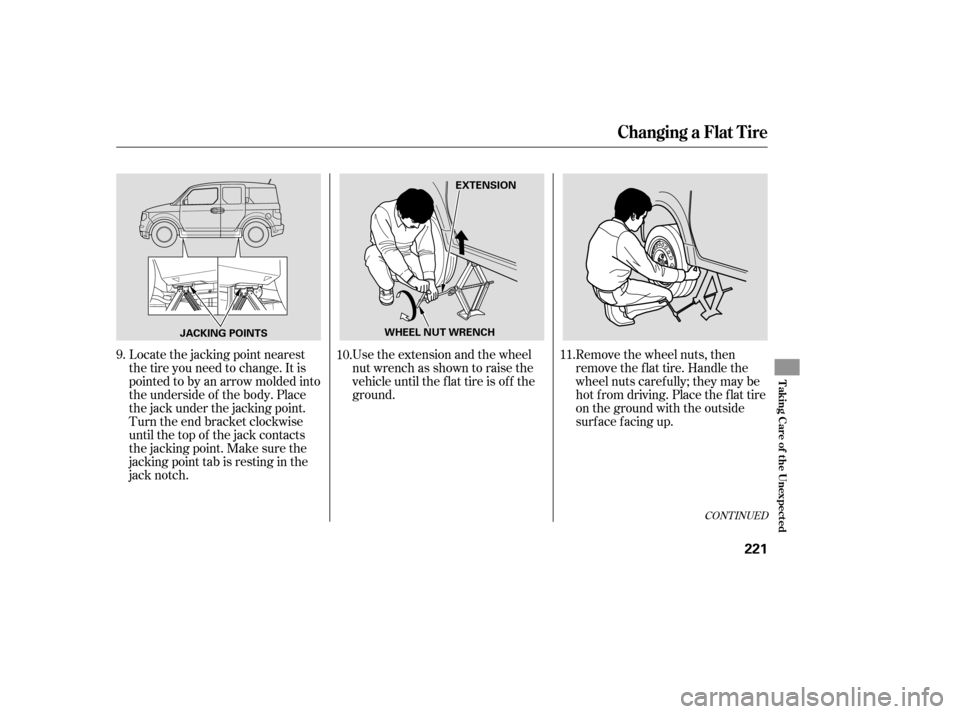
Locate the jacking point nearest
thetireyouneedtochange.Itis
pointed to by an arrow molded into
the underside of the body. Place
the jack under the jacking point.
Turn the end bracket clockwise
until the top of the jack contacts
the jacking point. Make sure the
jacking point tab is resting in the
jack notch.Use the extension and the wheel
nut wrench as shown to raise the
vehicle until the f lat tire is of f the
ground.
Remove the wheel nuts, then
remove the f lat tire. Handle the
wheel nuts caref ully; they may be
hot from driving. Place the flat tire
on the ground with the outside
surface facing up.
9.
10. 11.
CONT INUED
Changing a Flat Tire
T aking Care of t he Unexpect ed
221
EXTENSION
JACKING POINTS WHEEL NUT WRENCH
Page 225 of 275
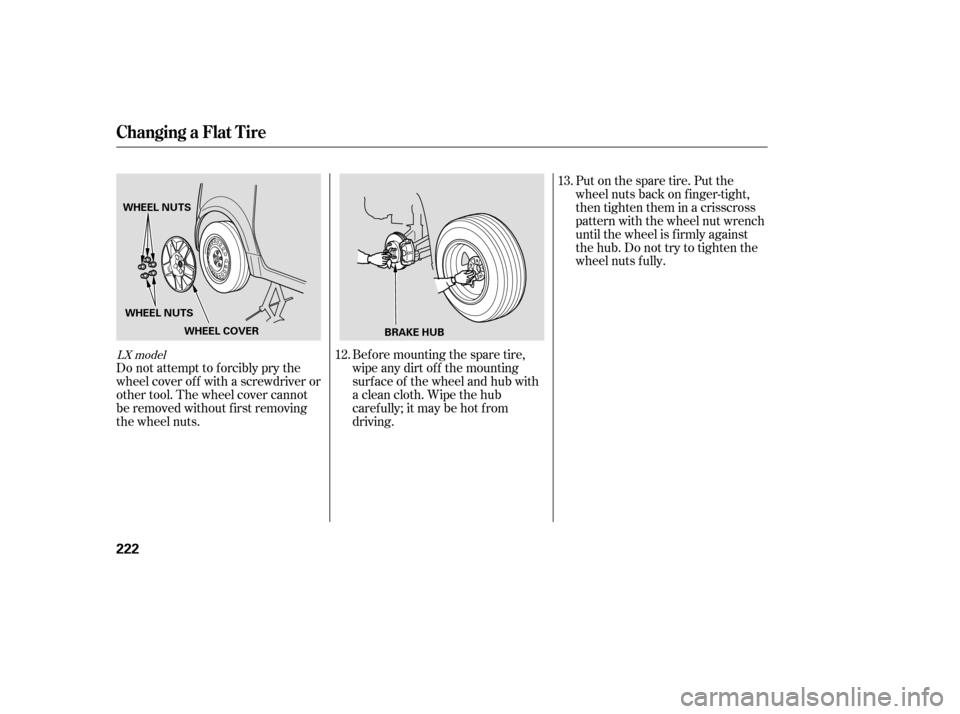
Bef ore mounting the spare tire,
wipeanydirtoff themounting
surface of the wheel and hub with
a clean cloth. Wipe the hub
carefully;itmaybehotfrom
driving.Put on the spare tire. Put the
wheel nuts back on f inger-tight,
then tighten them in a crisscross
pattern with the wheel nut wrench
until the wheel is f irmly against
the hub. Do not try to tighten the
wheel nuts f ully.
Do not attempt to forcibly pry the
wheel cover of f with a screwdriver or
other tool. The wheel cover cannot
be removed without f irst removing
the wheel nuts. 13.
12.LX model
Changing a Flat Tire
222
BRAKE HUB
WHEEL COVER
WHEEL NUTS
WHEEL NUTS
Page 226 of 275
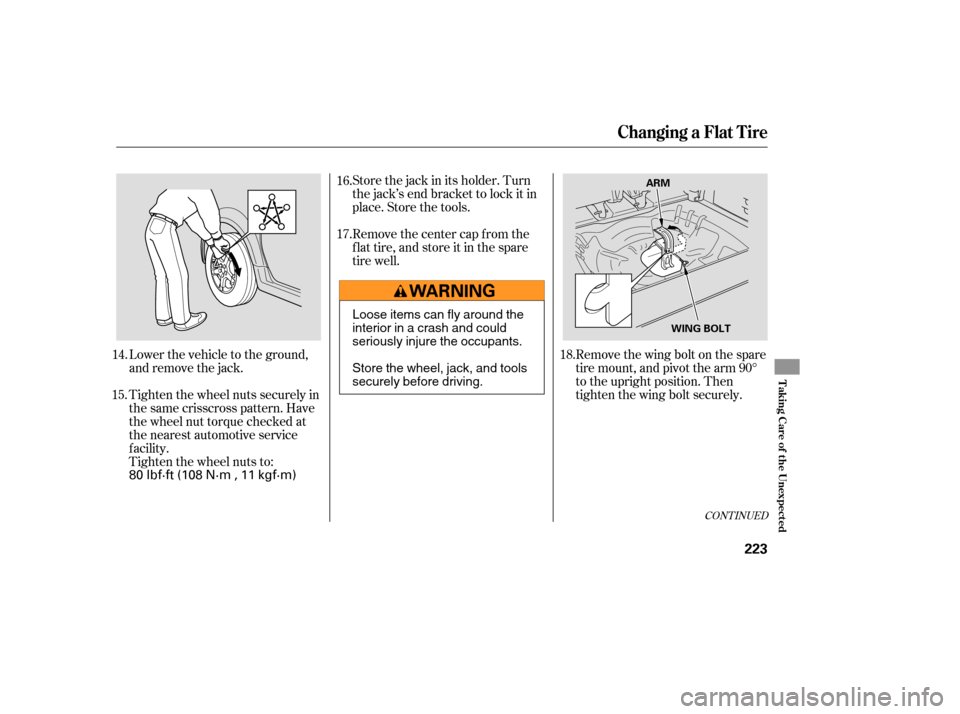
Store the jack in its holder. Turn
the jack’s end bracket to lock it in
place. Store the tools.
Remove the center cap from the
f lat tire, and store it in the spare
tire well.Removethewingboltonthespare
tire mount, and pivot the arm 90°
to the upright position. Then
tighten the wing bolt securely.
Tighten the wheel nuts securely in
the same crisscross pattern. Have
the wheel nut torque checked at
the nearest automotive service
f acility.
Tighten the wheel nuts to: Lower the vehicle to the ground,
and remove the jack. 18.
16.
17.
14.
15.
CONT INUED
Changing a Flat Tire
T aking Care of t he Unexpect ed
223
WING BOLT
ARM
80 lbf·ft (108 N·m , 11 kgf·m)
Loose items can fly around the
interiorinacrashandcould
seriously injure the occupants.
Store the wheel, jack, and tools
securely before driving.
Page 227 of 275

Remove the small round plug f rom
the cargo area f loor by pushing it
fromthebacksidetomakeahole.
Storetheremovedpluginaplace
you can easily remember.Reinstall the cargo area f loor.
Place the flat tire face down on the
cargo area f loor.
Align the center of the f lat tire
with the hole in the cargo area
f loor. Remove the spacer cone
from the wing bolt, turn it over,
and put it back on the bolt.Secure the f lat tire by screwing
thewingbolttothesparetire
mount through the hole in the
cargo area f loor.
19. 20. 21.22.
Changing a Flat Tire
224
WING BOLT
SPACER CONE
Page 228 of 275

Diagnosing why the engine won’t
start falls into two areas, depending
on what you hear when you turn the
ignition switch to the START (III)
position: Wh
en you turn the ignition switch to
the START (III) position, you do not
hear the normal noise of the engine
trying to start. You may hear a
clicking sound, a series of clicks, or
nothing at all. Turn
the ignition switch to the
START (III) position. If the
headlights do not dim, check the
condition of the fuses. If the fuses
areOK,thereisprobably
something wrong with the
electrical circuit for the ignition
switch or starter motor. You will
need a qualified technician to
determine the problem. See
on page .
If the headlights dim noticeably or
go out when you try to start the
engine, either the battery is
discharged or the connections are
corroded. Check the condition of the
battery and terminal connections
(see page ). You can then try
jump starting the vehicle from a
booster battery (see page ).
You
hear nothing, or almost
nothing. The engine’s starter
motor does not operate at all, or
operates very slowly.
You can hear the starter motor
operating normally, or the starter
motor sounds like it is spinning
faster than normal, but the engine
does not start up and run.
Turn the ignition switch to the ON
(II) position. Turn on the
headlights, and check their
brightness. If the headlights are
very dim or do not come on at all,
the battery is discharged (see on page ).
Check the transmission interlock.
If you have a manual transmission,
the clutch pedal must be pushed
all the way to the f loor or the
starter will not operate. With an
automatic transmission, the shif t
lever must be in Park or neutral.
Check these things:
227 227
214 239
CONT INUED
Nothing Happens or the Starter
Motor Operates Very Slowly
Emergency T owing
Jump Starting
If theEngineWon’tStart
T aking Care of t he Unexpect ed
225
Page 229 of 275

Are you using a properly coded
key? An improperly coded key will
cause the immobilizer system
indicator in the instrument panel
to blink rapidly (see page ).
In
this case, the starter motor’s
speed sounds normal, or even faster
than normal, when you turn the
ignition switch to the START (III)
position, but the engine does not run.
Are you using the proper starting
procedure? Refer to
on page . Do
you have fuel? Check the fuel
gauge; the low fuel indicator may
not be working.
There may be an electrical
problem, such as no power to the
fuel pump. Check all the fuses
(see page ).
Ifyoufindnothingwrong,youwill
need a qualified technician to find
the problem (see
on page ).
62 234
239
152
T he Starter Operates Normally
Starting the
Engine Emergency
Towing
If theEngineWon’tStart
226
Page 230 of 275
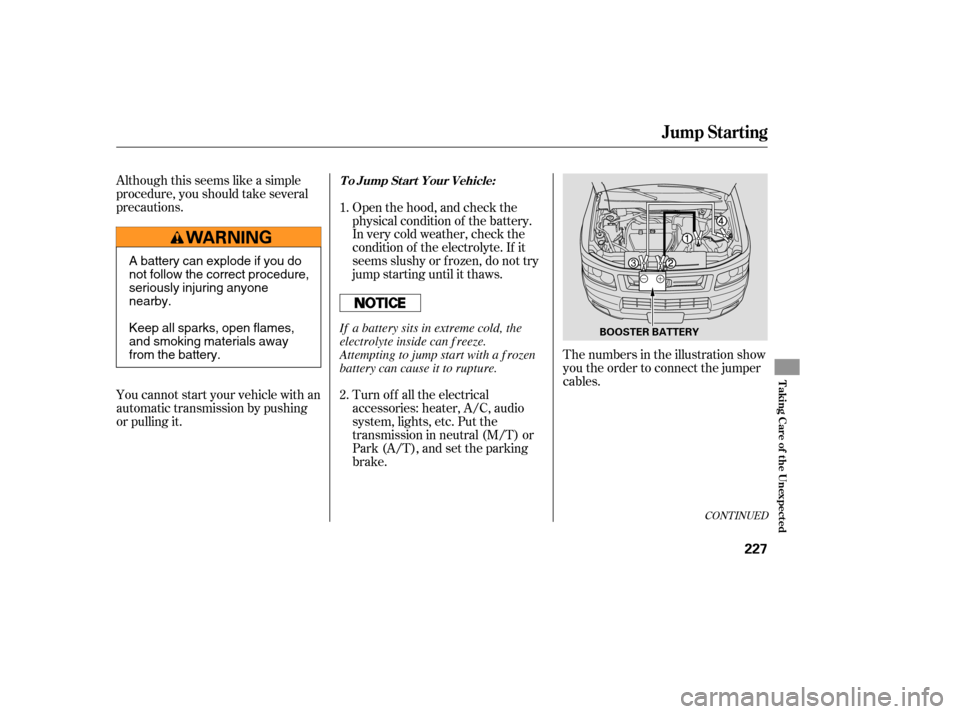
Although this seems like a simple
procedure, you should take several
precautions.
You cannot start your vehicle with an
automatic transmission by pushing
or pulling it.The numbers in the illustration show
you the order to connect the jumper
cables.
Turn of f all the electrical
accessories: heater, A/C, audio
system, lights, etc. Put the
transmission in neutral (M/T) or
Park (A/T), and set the parking
brake. Open the hood, and check the
physical condition of the battery.
In very cold weather, check the
condition of the electrolyte. If it
seems slushy or f rozen, do not try
jump starting until it thaws.
1.
2.
CONT INUED
To Jump Start Your Vehicle:
Jump Starting
T aking Care of t he Unexpect ed
227
BOOSTER BATTERY
A battery can explode if you do
not follow the correct procedure,
seriously injuring anyone
nearby.
Keep all sparks, open flames,
and smoking materials away
from the battery.
If a battery sits in extreme cold, the
electrolyte inside can f reeze.
Attempting to jump start with a f rozen
battery can cause it to rupture.